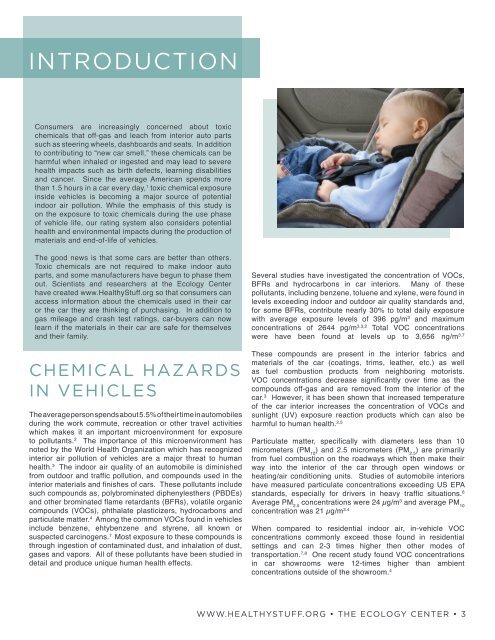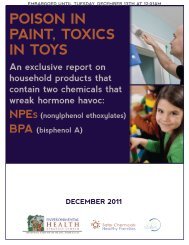Download the 2011/2012 Guide to New Vehicles - HealthyStuff.org
Download the 2011/2012 Guide to New Vehicles - HealthyStuff.org
Download the 2011/2012 Guide to New Vehicles - HealthyStuff.org
Create successful ePaper yourself
Turn your PDF publications into a flip-book with our unique Google optimized e-Paper software.
INTRODUCTIONConsumers are increasingly concerned about <strong>to</strong>xicchemicals that off-gas and leach from interior au<strong>to</strong> partssuch as steering wheels, dashboards and seats. In addition<strong>to</strong> contributing <strong>to</strong> “new car smell,” <strong>the</strong>se chemicals can beharmful when inhaled or ingested and may lead <strong>to</strong> severehealth impacts such as birth defects, learning disabilitiesand cancer. Since <strong>the</strong> average American spends morethan 1.5 hours in a car every day, 1 <strong>to</strong>xic chemical exposureinside vehicles is becoming a major source of potentialindoor air pollution. While <strong>the</strong> emphasis of this study ison <strong>the</strong> exposure <strong>to</strong> <strong>to</strong>xic chemicals during <strong>the</strong> use phaseof vehicle life, our rating system also considers potentialhealth and environmental impacts during <strong>the</strong> production ofmaterials and end-of-life of vehicles.The good news is that some cars are better than o<strong>the</strong>rs.Toxic chemicals are not required <strong>to</strong> make indoor au<strong>to</strong>parts, and some manufacturers have begun <strong>to</strong> phase <strong>the</strong>mout. Scientists and researchers at <strong>the</strong> Ecology Centerhave created www.<strong>HealthyStuff</strong>.<strong>org</strong> so that consumers canaccess information about <strong>the</strong> chemicals used in <strong>the</strong>ir caror <strong>the</strong> car <strong>the</strong>y are thinking of purchasing. In addition <strong>to</strong>gas mileage and crash test ratings, car-buyers can nowlearn if <strong>the</strong> materials in <strong>the</strong>ir car are safe for <strong>the</strong>mselvesand <strong>the</strong>ir family.CHEMICAL HAZARDSIN VEHICLESThe average person spends about 5.5% of <strong>the</strong>ir time in au<strong>to</strong>mobilesduring <strong>the</strong> work commute, recreation or o<strong>the</strong>r travel activitieswhich makes it an important microenvironment for exposure<strong>to</strong> pollutants. 2 The importance of this microenvironment hasnoted by <strong>the</strong> World Health Organization which has recognizedinterior air pollution of vehicles are a major threat <strong>to</strong> humanhealth. 3 The indoor air quality of an au<strong>to</strong>mobile is diminishedfrom outdoor and traffic pollution, and compounds used in <strong>the</strong>interior materials and finishes of cars. These pollutants includesuch compounds as, polybrominated diphenyles<strong>the</strong>rs (PBDEs)and o<strong>the</strong>r brominated flame retardants (BFRs), volatile <strong>org</strong>aniccompounds (VOCs), phthalate plasticizers, hydrocarbons andparticulate matter. 4 Among <strong>the</strong> common VOCs found in vehiclesinclude benzene, ehtybenzene and styrene, all known orsuspected carcinogens. 7 Most exposure <strong>to</strong> <strong>the</strong>se compounds isthrough ingestion of contaminated dust, and inhalation of dust,gases and vapors. All of <strong>the</strong>se pollutants have been studied indetail and produce unique human health effects.Several studies have investigated <strong>the</strong> concentration of VOCs,BFRs and hydrocarbons in car interiors. Many of <strong>the</strong>sepollutants, including benzene, <strong>to</strong>luene and xylene, were found inlevels exceeding indoor and outdoor air quality standards and,for some BFRs, contribute nearly 30% <strong>to</strong> <strong>to</strong>tal daily exposurewith average exposure levels of 396 pg/m 3 and maximumconcentrations of 2644 pg/m 3.3,2 Total VOC concentrationswere have been found at levels up <strong>to</strong> 3,656 ng/m 3.7These compounds are present in <strong>the</strong> interior fabrics andmaterials of <strong>the</strong> car (coatings, trims, lea<strong>the</strong>r, etc.) as wellas fuel combustion products from neighboring mo<strong>to</strong>rists.VOC concentrations decrease significantly over time as <strong>the</strong>compounds off-gas and are removed from <strong>the</strong> interior of <strong>the</strong>car. 3 However, it has been shown that increased temperatureof <strong>the</strong> car interior increases <strong>the</strong> concentration of VOCs andsunlight (UV) exposure reaction products which can also beharmful <strong>to</strong> human health. 2,5Particulate matter, specifically with diameters less than 10micrometers (PM 10) and 2.5 micrometers (PM 2.5) are primarilyfrom fuel combustion on <strong>the</strong> roadways which <strong>the</strong>n make <strong>the</strong>irway in<strong>to</strong> <strong>the</strong> interior of <strong>the</strong> car through open windows orheating/air conditioning units. Studies of au<strong>to</strong>mobile interiorshave measured particulate concentrations exceeding US EPAstandards, especially for drivers in heavy traffic situations. 6Average PM 2.5concentrations were 24 µg/m 3 and average PM 10concentration was 21 µg/m 3.4When compared <strong>to</strong> residential indoor air, in-vehicle VOCconcentrations commonly exceed those found in residentialsettings and can 2-3 times higher <strong>the</strong>n o<strong>the</strong>r modes oftransportation. 7,8 One recent study found VOC concentrationsin car showrooms were 12-times higher than ambientconcentrations outside of <strong>the</strong> showroom. 4WWW.HEALTHYSTUFF.ORG • THE ECOLOGY CENTER • 3




